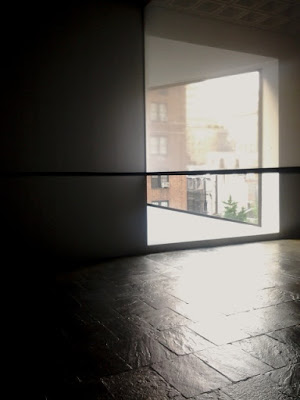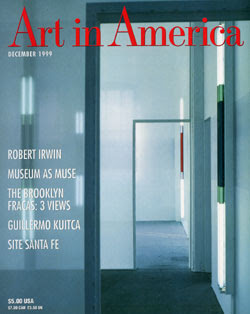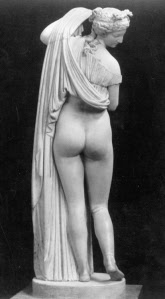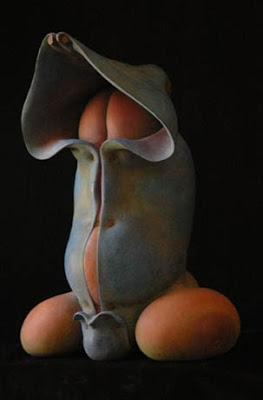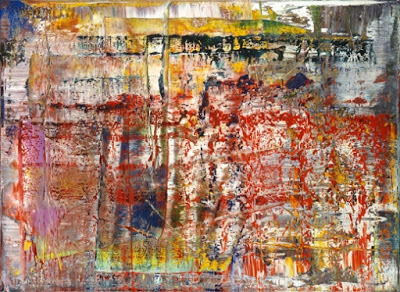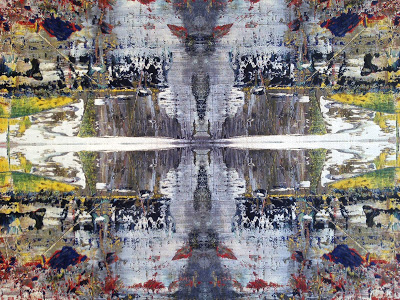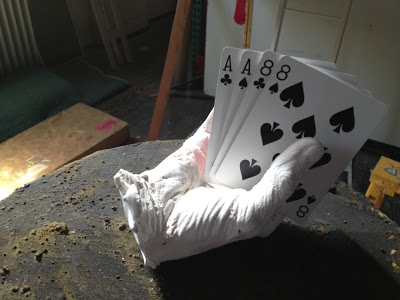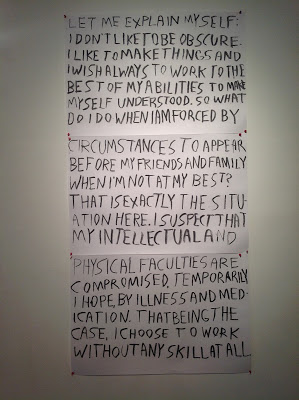2013
November 3, 2013
If anything, by completely obscuring Frank Lloyd Wright’s architecture with his installation, James Turrell reaffirmed my already profound love for the Guggenheim–like the new appreciation one might have for a healed limb after the cast has been removed.
At the museum Friday for the Christopher Wool exhibition, I was reminded of how Wright created not just a place for art, but for people—a social space in one big room that hums like a party. In most museums the other visitors are annoyances, always in the way, going the wrong direction, talking too loudly or blocking the view—but at the Guggenheim they’re fellow travellers. The ramp is like a sidewalk where you can stop and chat (no need to whisper); it respects your pace. You can see what’s ahead above or across the atrium and get exited about it in advance, stand as close or look as far as you want. What other museum offers a view from over 100 feet?
Plus the natural light that comes in from the skylight at the top….
In the usual rectangular museum gallery, I’m overly conscious of the amount of time I’m spending in front of something, and am always torn – should I be looking at this or this or is there something more interesting behind me? What am I missing? And this time at the Guggenheim, when I exited the ramp to see the paintings installed in the one conventional room, they lost some of their dynamism. I didn’t want to be there, enclosed, with no windows. I wanted to be “outside.”
I not only remember the work in exhibitions I’ve seen at the Guggenheim, I remember where it was situated and how it felt to come upon it—the “uninterrupted, beautiful symphony” of architecture and art Wright intended.
Further, there’s a single toilet or two at every level, so no need to descend to a dungeon and crowd into the usual bathroom horribleness—how civilized is that?
Our forebears made art on the walls of caves with no right angles. I think they had had the right idea.
Comments (4)
October 4, 2013
September 11, 2013
In my previous post about James Turrell at the Guggenheim and Robert Irwin’s re-installation of Scrim Veil-Black Rectangle-Natural Light, 1977 at the Whitney (June 27-Sept 1, 2013), I suggested that Irwin might have taken Marcel Breuer’s trapezoidal window as his starting point, given that the window’s narrow black frame appeared to share both color and dimension with his long horizontal bar and the painted black stripe that runs, also horizontally, around the walls. When I wrote to the museum for exact measurements, however, I was told “the curators are unaware of any correlation between the dim [frame] on the window and the width of the black stripe.” Knowing the precise observation inherent in Irwin's work, I decided to put the question to the artist himself. In doing so I gained insight into what Irwin was thinking when he first entered the Whitney gallery 35 years ago, and how the philosophy that drove that piece is still at play in his work today. The following is from a phone conversation on September 3, 2013.
Robert Irwin, Scrim Veil-Black Rectangle-Natural Light, 1977 (reinstalled). Photo: Vaughn Tan
CD: I wrote in my post that the window, whose black frame roughly matches the elements you added, appeared to be your starting point. Is that so?
CD: I wrote in my post that the window, whose black frame roughly matches the elements you added, appeared to be your starting point. Is that so?
RI: No. The first thing that struck me when I entered the room at the Whitney, was the black floor. Then there’s the ceiling, not handsome, but a factor, and the quality of the light from the window, the way it disintegrates over the length of the space. And, of course, the sheer size of the room – an empty room of that scale is something you don’t generally encounter in New York. The window is the architect’s revenge; the angles are a perfect perspective to the buildings across the street, and it has a pictorial element, which make’s it almost impossible to show a painting there. Most of the time they have to hide the window. The window is a detail, but not a principal one.
Normally when you walk into the room you take a check—the first responsibility of perception is to keep from being killed—so you check coordinates, rapidly. But I did something at the Whitney that doesn’t stand out, which was paint the wall opposite the window a shade that’s considerably brighter than the other walls—if you were to turn a light on in the room at night, you’d see that it was about 65% gray. So when you come in, you know that something’s not quite right, but only subliminally.
The situation was an opportunity to make a statement about the idea of “conditional” —as well as how, and in what way, the conditional acts in world.
What do you mean by “conditional”?
Instead of being in the studio and conceiving things, the artist isolated in the frame, the idea is that the perceiver can deal with the world itself and make all kinds of value judgments, engage the cognitive self to make decisions in the world. I was intrigued by the idea that rather than creating a metaphor, an artist can function directly in the world….
…and eliminate the “frame,” which includes wall text, labels—all the paraphernalia that designates a thing as “art” and separates it from life.
Yes, in my very first show at MoMA, with Jenny Licht back in 1970, they put a label on the wall and I hired someone to come in and take it off. So when you walked into the room you had to go through the process of asking yourself “Is this thing finished? Is it intended?”
It’s about using the same elements in the museum and the outside world, making something, but not really making anything, just pointing it out. If we take the history of modern art as a question, does “making” equal “art”? Is it necessary to make something or can it be about operating in the world as it is? I just took it one step farther.
The one thing that distinguishes each of my students from the other is an individual sensibility; my job as a teacher is to help them find that key element, and develop it. So I come to a situation and add to that existing dialogue from what’s at the core of my being an artist.
I’m not a landscape designer, but made a garden at the Getty. The same with the design of the Dia:Beacon. I am not an architect.
Getty Garden. iPhone photograph. f/2.8. Copyright (c) Joanne Mason 2011.
I recently had a conversation with an artist, and when I told him you designed the Dia:Beacon, he said, “But there’s nothing there. He didn’t really do anything to it.” He meant that your signature wasn’t on it. I thought you’d like that.
When I consider a space, I don’t have to bring to it other kinds of abstract rationale.
The Dia doesn’t act as a piece of art. When architects design museums, they are creating major pieces of sculpture. In the beginning, they have pure intentions, but when it becomes big business, they start to act as if they’re artists. It’s unethical to build a building that doesn’t function.
So getting back to the Whitney, it can’t be coincidence that the frame around the window matches the bar and painted stripe.
No, of course not. The window is definitely an element in the vocabulary. And there are only a few others in that space: the floor, the disintegration of light over the space, the ceiling. Of those the disintegration of the light was probably the most appealing aspect for me. The light is a subject that goes through this amazing exercise before your eyes, which the scrim then multiplies...sometimes opaque, sometimes transparent.
It’s interesting that your show coincided with Turrell’s at the Guggenheim – both involving space, light, iconic architecture….
But it’s not fair to compare Turrell’s current work with something I did 35 years ago—35 years is a long time in a life. And when I did it, it was like I threw a rock in a pond and there were no ripples. Now it’s a cause célèbre; it just took that amount of time to get back to me. The same with a column I made in 1971, that's just now found a home in the San Diego Federal Courthouse.
I can understand why, though. At the exhibition I saw at Chicago’s MCA in 1975, you did two pieces: the scrim wedge and one that was simply—to my mind at the time—a black bar running around the floor. I was hugely affected by the scrim piece, but it was too early in my life as an artist for me to understand the other. Now I would get it in a flash. Maybe people are just catching up.
Robert Irwin, Museum of Contemporary Art, Chicago, 1975.
Further reading: Carol Diehl, "Robert Irwin: Doors of Perception," Art in America, December, 1999.
Robert Irwin, Museum of Contemporary Art, Chicago, 1975.
Further reading: Carol Diehl, "Robert Irwin: Doors of Perception," Art in America, December, 1999.
August 26, 2013
Every hue throughout your work is altered by every touch you add in other places.
—John Ruskin
The work promotes a state of contemplation in a communal viewing space, rekindling the museum’s founding identity as a “temple of spirit”—Guggenheim Museum press release for James Turrell’s Aten Reign, on view through September 25, 2013.
For the past several weeks I’ve been trying to make sense of my profound underwhelm with James Turrell’s otherwise much-touted light extravaganza at the Guggenheim. I love the Guggenheim; the architecture makes any reason to go there a special event, and now one of my most-admired artists has filled the atrium with a giant hollow cone of light and color which, ovoid and tiered like a wedding cake, floats over a seating area like a flying saucer. Gently diffused by the cone’s scrim-like fabric, LED lights gradually shift from one gradated color to another, while muted natural light filters in through the skylight. What’s not to like?
It should be right up my alley. Turrell’s permanent installation at MoMA/PS1, Meeting (1986) is at the top of my ten best list. In addition, I’ve spent a good part of my professional life writing about Robert Irwinand Olafur Eliasson, who work with perception and light in similar ways. I also have a special affinity with Turrell because I, too, come from Quaker stock and have been a practicing Quaker. Meditation and contemplation are important parts of my life.
However, seated in the atrium at the press preview, instead of going into rapture, I began thinking about Eliasson’s circular 360°Room(s) for all Colors of similarly changing hues. There visitors are highlighted participants, lit like fashion models against a seamless background, where here they appeared to have little relationship with the piece that hovered above them. I also thought about how, in those Eliasson pieces, you can walk right up to the “wall,” which seems to have no substance but that of color, and practically put your nose in it—while the entire experience Turrell has created at the Guggenheim is “up there.” Not significantly related to the scale of my body, it felt separate from me, which meant I didn’t have the desired heightened awareness of my place in it—I was not, to employ the overused phrase, “seeing myself seeing”—any more than I would at a fireworks display. In every work of art the “here” and “there” are important aspects; to be fully satisfying, I want even a painting to tell me something up close as well as from a distance. In an installation, it’s even more important, because if my situation as a visitor isn’t fully developed, I don’t feel a connection with whatever else is going on.
Olafur Eliasson. 360° room for all colours. 2002. Stainless steel, projection foil, fluorescent lights, wood, and control unit, 126 x 321 x 321" (320 x 815.3 x 815.3 cm). Private collection. Installation view at Musée d'Art moderne de la Ville de Paris. Courtesy Tanya Bonakdar Gallery, New York. © 2008 Olafur Eliasson
The most important aspect, however, of “seeing ourselves seeing” is that our perception is challenged to the point that we no longer trust our normal visual clues. This produces a particular state of self-consciousness that merges with the work—and at this, Turrell has been a master. In his Skyscapes, like the one at PS1, the sky becomes a “thing” you feel you could almost touch, with the result that you find yourself simultaneously questioning it and yourself. And looking at one of his early, simple corner light projections, your brain processes it as a cube with actual mass, even though you know it isn’t. Nothing like that happens at the Guggenheim; while it’s beautiful, even stunning, there’s no mystery. What you see is what you get—an indication that the line between art and lighting design (which has become extremely sophisticated through the influence of artists) is now very, very thin.
James Turrell, Meeting(1986) MoMA/PS1. Photo: Carol Diehl, 2011
“He’s an orchestrator of experience,” Chuck Close has said of Turrell—but what makes up that experience? Where does it start and stop? Does it begin when you hear about it from a friend, or read a review? Those are things the artist can’t control, but he can influence what happens from the minute you walk through the door.
And what’s that like? My friend, David, a hospital administrator who made the mistake of visiting the Guggenheim with his out-of-town family on a weekend, described it as…“Horrible. Like Disneyland. There were 4-5 lines squeezed into the walled-off lobby, and you’re trying to get in line and bumping into everyone…and once you get your ticket and come into the atrium you’re trying to look up but can’t because there are so many people. It was pretty, but hardly transcendent. The architecture was all covered up and you could have been anywhere. And then, still bumping into people, you walked up the walled-off ramp, which felt like a missed [artistic] opportunity, to stand in more lines. Not that we were looking to be entertained, but we were looking for $20 worth of something.”
Another friend said the guards were ordering people around, telling them to get off the floor if they tried to lay on it….”It’s not their fault,” he said, “They were only doing their job, but it could have been managed better.”
So how much of that has to do with Turrell? I think it all does.
Much to the annoyance of painting students when I refuse to overlook a warped stretcher (the perpetual question being, “Is this intentional?”), I have always contended that everything that falls into my experience is part of the piece—a view that has fueled my no-doubt tedious bloggy diatribes against artists’ statements, wall text, audio tours, black-out curtains, headphones, etc.
I was irritated when, a few years ago, I found that entrance to a Turrell installation, required shedding my shoes and donning floppy Tyvek protective booties. While surely an over-reaction on the part of one who’s invested too much in her fashion statement, I interpreted this as a power play on the part of the artist (“Really? Part of your piece is to make me look ridiculous?”).
So yes, in my book, the queues, crowd control, and the need for crowd control are all part of it. This is, after all, the same museum that, in 2010, featured relational aesthetics guru, Tino Seghal, whose piece involved engaging visitors in conversation. After that and many similar, such as Martha Rosler’s garage sale and Marina Abramović’s The Artist is Present, both recently at MoMA, it would be arbitrary to insist that personal interactions are significant in one circumstance, but not in another.
Eliasson (who was largely inspired by Robert Irwin, also my biggest influence, and now both have shaped my thinking) was aware of this responsibility on the part of the artist back in 2003, when he configured his monumental weather project at the Tate Modern. Approaching the institution as a whole, part of his preparation involved talking to members of each of the museum’s departments to discuss how their roles would impact his project.
Olafur Eliasson, weather project (2003), Tate Modern
Eliasson also configured something that could handle the crowds it brought—which raises a related question: what is the artist’s accountability to the social situation his work is creating and/or occupying? For defenders of Richard Serra’s threatening Tilted Arc, which after much controversy, was ultimately removed from a busy office plaza, the answer was “None.” But much has gone on since 1989, with artists now more aware of, and willing to embrace, the public nature of their work. If relational aesthetics has had a positive impact, it has been to highlight the artist’s role in configuring the entire art experience.
All of this casts doubt on the decision to turn Frank Lloyd Wright’s soaring masterpiece into a confined area that requires limited entrance—and attempt to create a relatively intimate space in a public institution whose most basic function is to accommodate large numbers of people. Another power play perhaps?
I like to think of “generosity” in terms of public sculpture/installation, as a measure of the number of ways a work may fulfill the artist’s intention to successfully affect his audience. For example, few works are more “generous” than Anish Kapoor’s Cloud Gate in Chicago’s Millennium Park. Installed in 2006 and nicknamed “The Bean” for its shape, this giant organic structure of highly polished stainless steel is engaging day and night, from afar, up close, and even underneath, involves light, reflection, and movement, and is as affective in the presence of crowds as it would be in solitude.
Anish Kapoor, Cloud Gate (2003-6), video: Carol Diehl (2012).
This is not to say that art has to be popular or even pleasing, but that it fulfills its purpose on every level. Therefore, if the intention of a piece was about the frustration of not being able to see it, say, then the question of its success would be, was everyone sufficiently frustrated?
Frustration and contemplation, however, do not go together.
Frustration and contemplation, however, do not go together.
Meanwhile, the frustration at the Guggenheim continues even after one leaves the atrium and attempts to see Turrell’s earlier works by joining the crowds to ascend the museum’s curving ramps, now claustrophobic tunnels with “walls” of opaque white fabric that block any view of the atrium. As students know, one of the first questions one asks when evaluating any sculpture is, does it perform equally well from all sides, or does it have a “dead zone?” This is something sculptors like Mark de Suvero and Richard Serra have obviously given a lot of thought to—as did the ancient Greeks. And especially now that sculpture engages the scale and dynamics of architecture, just as with personal interactions, it seems arbitrary to insist that we shouldn’t take the outside of Turrell’s cone into consideration as an integral part of the piece—it was, as my friend, David, put it, a “missed opportunity.”
ROBERT IRWIN: SCRIM VEIL—BLACK RECTANGLE—NATURAL LIGHT, WHITNEY MUSEUM OF AMERICAN ART, NEW YORK (1977)
JUNE 27–SEPT 1, 2013 Photo: Carol Diehl 2013PART II Robert Irwin on "Scrim Veil-Black Rectangle-Natural Light (1977)" recently at the Whitney
Further reading:
Roberta Smith on Turrell "New Light Fixture for Famous Rotunda" and Irwin "Ineffable Emptiness: From Dawn to Dusk"
Gabrielle Selz "Considering Perception: Robert Irwin and James Turrell": a look at their shared history.
Lee Rosenbaum: "Turrell's Skyspace Obscures the Sky"
Blake Gopnik: "Has the Sage Turrell Sold Out?"
July 27, 2013
I just got an email from the Park Avenue Armory that Paul McCarthy’s installation is over August 4th. And not a moment too soon!
Debauchery seems so old fashioned, so last century, that McCarthy’s attempt to shove it down our throats (haha) with this massive installation seems almost quaint. There was a time when it might have been helpful to goose us (there I go again) out of our inhibitions, but we were liberated decades ago. We had the 60s, 70s, and 80s, “Satyricon,” “Last Tango,” “Eyes Wide Shut” and that Japanese film where the guy cuts off his penis—not to speak of Acconci masturbating under a platform and Mapplethorpe, whose S&M photos are now classics. With the exception of the New York Post and a few mouthpieces on the Christian Right we are, as a culture, un-shockable—and even those starched shirts are probably not really shocked, but simply using it as another weapon in their power play. In an era where Internet porn of every flavor is available 24/7, we need more debauchery like we need another film about cars blowing up.
Robert Mapplethorpe, Untitled, c. 1973 © Robert Mapplethorpe Foundation. Used by permission.
Further, it’s easy to be depraved—just as it’s easier to be sloppy than scrupulous, disgusting than poetic. The irony is that McCarthy, whose work is a reaction to super-scrubbed, sexually-repressed Disney productions, is not more artful than his stimulus. Like Disney, he insists on controlling the entire experience, leaving no room for the imagination.
Compare McCarthy’s heavy-handed interpretation with Judy Fox’s Snow White (2007), whose simple representation of a adolescent girl in all of her nakedness and vulnerability is actually more disturbing.
Not to speak of her dwarfs--here Sloth (2007), not a character you'd like to find yourself in a dark corner with:
Judy Fox, Sloth2007 terra cotta and casein, 21 x 16 x 16.5 inches
Judy Fox, Sloth2007 terra cotta and casein, 21 x 16 x 16.5 inches
I was thinking that the most responsive audience for McCarthy’s piece would be the seventh-grade boys who won’t be allowed in, which led me to wonder what would happen if you got a bunch of those boys, gave them an unlimited budget, and told them to be as gross as they wanted. Now that might be interesting. It might even be funny.
*****
Jerry Saltz on the McCarthy exhibition here.
July 13, 2013
For the first time in almost ever, I took a couple of months off from writing….anything. I was tired of having ideas, tired of the urgency to express them, wanted to concentrate on making art, not thinking about it. Well I found it didn’t pay—just like avoiding the gym doesn’t pay—because now what I’m left with is mental flab and a limp writing muscle. A paragraph that just a few months ago would take five minutes to write, now takes an entire morning—with myriad breaks for coffee and food. Therefore, like not exercising, not writing can be fattening—especially in England, where I am until tomorrow, and where everything goes better with double cream.
Also I hadn’t seen any art that knocked my socks off. The Paul McCarthy show at the Armory put me in such a bad mood, and even the Turrell installation at the Guggenheim, which I wanted to like in the worst way (more about that in another post), left me cold. I fled to Paris, anticipating “Dynamo,” an exhibition of sound and motion at the Grand Palais, but it was the white cheese and passion fruit dessert in the museum café that really turned me on. Sometimes I think I’ve chosen the wrong field.
However if anyone can pull me out of a torpor, it’s Gerhard Richter. Usually there’s a lot on in the London summer season, but this year the only thing I really wanted to see was the exhibition(up through July 27) at Gagosian on Davies Street of four Richter tapestries from 2009—which, as it turned out, could be his most magnificent work ever.
The tapestries are based on a single scraped painting: Abstract Painting (724-4) (1990). This is the same one he mined for his book, Patterns: Divided, Mirrored, Repeated(2012), from which he generated the the large-scale digital Strip Paintings, shown at Marian Goodmanlast season, which I reviewed for Art in America.
Gerhard Richer, Abstract Painting (724-4) (1990)
Woven on a mechanical jacquard loom, each tapestry represents a Rohrschach-like four-time multiplication of one quadrant of the original image. Dense and rich, they appear at once medieval and futuristic, tribal and Baroque, with varying texture, thick and thin, and colors that range from murky to brilliantly clear.
While my friend and I stood riveted for at least 20 minutes, a couple with a car and driver waiting outside, entered the otherwise empty storefront gallery, walked up to one tapestry, said “Wow!” and walked out.
Although photos cannot possible replicate the experience, here are some attempts (oddly, my iPhone photos have more vibrant color than the official ones):
Gerhard Richter, Tapestries, 2009 (Installation view)
Gerhard Richter, Tapestries, 2009 (Installation view)
Gerhard Richter, Tapestries (Detail)
Gerhard Richter, Tapestries, 2009 (Installation view)
Gerhard Richter, Tapestries, 2009 (Installation view)
Gerhard Richter, Tapestries (Detail)
June 18, 2013
I have not stopped blogging, but have simply been concentrating on drawing to the exclusion of everything else. I have no doubt that the desire to vent about something will overtake me again at some point and the floodgates will reopen. Please sign up for email alerts so you'll know when this happens. In the meantime:
Both are ink and graphite on Arches, 12" x 16", as yet untitled.
Both are ink and graphite on Arches, 12" x 16", as yet untitled.
May 23, 2013
Matt Freedman, Dead Man's Hand, epoxy and cards, 2013.
I’ve started writing this post a million times, but there’s no good way to begin. Okay, there’s an exhibition at Studio 10 in Bushwick by my beloved friend, Matt Freedman, who’s been strenuously treated for a rare form of cancer since the fall. The show, in Matt’s ironic, funny, touching, and self-deprecating way, is about his experience, and although heartbreaking, it’s not depressing. It’s just Matt, and art. Not art meant for the walls of the 1%, not art to further a career, not art meant to make a pithy statement about the human condition or to show off craft, but art made because Matt is an artist and this is how he processes the events of his life. If you want to know what art really is, this is it.
The title of the exhibition is “The Devil Tricked Me,” and indeed we could say the devil tricked all of us who know Matt, who has not a mean bone in his body. In the more than 20 years I’ve known him, I can’t remember hearing him say anything against anyone. Wickedly smart and without a shred of guile (two characteristics that often don’t go together), Matt's conversation tends toward humorous, gently ironic observation—as does his writing and art—and here he is observing himself face-to-face with mortality and his heroic attempts to thwart it. The 13 objects, all depicting folk admonitions of bad luck—broken mirrors, “three on a match,” stepping on a crack in the sidewalk—were made, for obvious reasons, without a lot of attention to craft. Yet nothing could be more heart wrenching than Matt’s pile of open and slightly crushed umbrellas, those fragile objects made to protect us that can so often fail. And the rainbow-colored ladder, which we must walk under, could be a stairway to heaven or, as I prefer to think of it, a way out, the escape route back to normal life.
Along with the exhibition are reproductions, for sale, of the journal with sketches Matt made during his extreme treatment. Again, I can only read a little bit each day, but it’s a way of keeping Matt in my thoughts. As his friends, we won’t let the devil trick us—having Matt in our lives is some of the best luck we’ll ever have. We love you, Matt!
Update: And here, a detailed and eloquent review of the show by Thomas Mitchell.
Update: And here, a detailed and eloquent review of the show by Thomas Mitchell.

